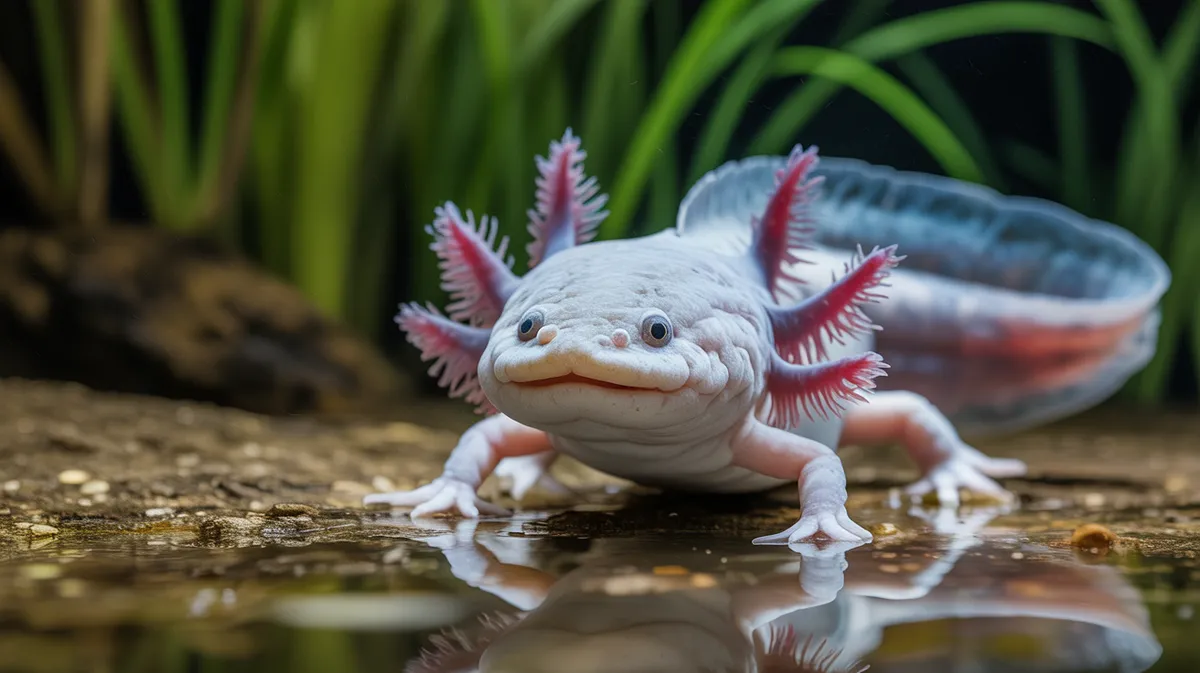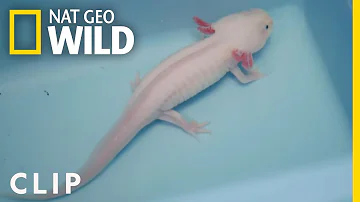
Axolotl
Ambystoma mexicanum

Meet the Axolotl
The axolotl is a unique species of salamander native to the freshwater lakes of central Mexico, most notably Lake Xochimilco. Unlike most amphibians, axolotls retain their larval features throughout their lives, a condition known as neoteny, which includes feathery external gills and a finned tail. They are capable of regenerating entire limbs, spinal cord, heart, and other organs, making them a subject of extensive scientific research. Axolotls are critically endangered in the wild due to habitat loss, pollution, and the introduction of invasive species.
Classification
Amphibian
Habitat
Freshwater lakes and canals
Diet
Carnivore
Lifespan
10-15 years
Conservation
Critically Endangered
Weight
60-200 grams
📖Fascinating Facts
Masters of Regeneration
Axolotls can regenerate entire limbs, parts of their heart, spinal cord, and even parts of their brain, a rare ability among vertebrates.
Fully Aquatic
Unlike most amphibians, axolotls remain aquatic and keep their larval features, such as external gills, throughout their lives.
Critically Endangered
Wild axolotl populations have declined drastically, with their native habitat suffering from urbanization, pollution, and invasive species.
📋Detailed Description
The axolotl (Ambystoma mexicanum) is a medium-sized salamander, typically reaching 23–28 cm in length, though some individuals can grow up to 30 cm. Its most distinctive features are its three pairs of feathery external gills, which protrude from the sides of the head and facilitate gas exchange in its fully aquatic environment. The axolotl's skin is smooth and ranges in color from wild-type dark brown/olive with gold speckling to leucistic (pale pink with red gills) and albino forms, especially in captivity. Unlike most amphibians, axolotls exhibit paedomorphosis, meaning they retain larval characteristics such as gills and a dorsal fin into adulthood and do not undergo complete metamorphosis unless induced by hormonal or environmental manipulation. Their eyes lack eyelids, and their broad, flattened heads are equipped with a wide mouth and small, lidless eyes. Axolotls possess remarkable regenerative abilities, being able to regrow entire limbs, parts of the spinal cord, heart, and even portions of the brain without scarring. They are primarily nocturnal, spending daylight hours hidden among aquatic vegetation or under debris. In the wild, axolotls are solitary and territorial, coming together only for breeding. Their diet consists mainly of small aquatic prey such as worms, insects, crustaceans, and small fish, which they capture via suction feeding. The axolotl's unique combination of neoteny, regenerative capacity, and adaptability to hypoxic environments has made it a model organism in developmental and regenerative biology.
💡 Did you know?
Axolotls almost never undergo metamorphosis, unlike most salamanders, and spend their entire lives in water.
🔬Research & Sources
Wikipedia Summary
The axolotl is a paedomorphic salamander, one that matures without undergoing metamorphosis into the terrestrial adult form; adults remain fully aquatic with obvious external gills. This trait is somewhat unusual among amphibians, though this trait is not unique to axolotls, and this is apparent as they may be confused with the larval stage or other neotenic adult mole salamanders, such as the occasionally paedomorphic tiger salamander widespread in North America; or with mudpuppies, which bear a superficial resemblance but are from a different family of salamanders.
Last Modified: 6/8/2025
🎭Behavior & Social Structure
Axolotls are generally sedentary, spending much of their time resting on the substrate or slowly swimming through the water. They are opportunistic carnivores, using a rapid suction mechanism to ingest prey, which includes aquatic insects, annelids, mollusks, and small fish. Hunting is primarily crepuscular or nocturnal, with axolotls relying on olfactory and lateral line senses to detect movement and chemical cues in the water. Social interactions are minimal outside of breeding, and individuals can become aggressive if housed together in confined spaces, sometimes resulting in cannibalism, especially among juveniles. Axolotls exhibit site fidelity and are known to establish small territories, which they defend by posturing and, occasionally, nipping. They are sensitive to environmental changes, responding to fluctuations in water temperature, oxygen levels, and pollution by altering their activity patterns.
👶Reproduction & Life Cycle
Axolotls breed primarily during the late winter and early spring, triggered by changes in water temperature and photoperiod. Courtship involves a series of ritualized displays, with the male performing a 'dance' to attract the female, followed by the deposition of spermatophores (packets of sperm) on the substrate. The female picks up the spermatophore with her cloaca, leading to internal fertilization. Females can lay between 100 and 1,000 eggs, attaching them individually to aquatic plants or debris. Embryonic development lasts 10–14 days at 20°C, after which larvae hatch and are immediately independent. There is no parental care post-oviposition. Sexual maturity is reached at 12–18 months, with individuals remaining in their aquatic, neotenic form unless exposed to thyroid hormones or environmental stressors, which can induce metamorphosis into a terrestrial adult.
🛡️Adaptations & Survival
The axolotl's most notable adaptation is its lifelong neoteny, allowing it to remain aquatic and retain larval features such as external gills and a finned tail. This adaptation is thought to be an evolutionary response to the stable, cool, and oxygen-rich waters of its native habitat. Its regenerative abilities are among the most advanced in the animal kingdom, enabling the restoration of complex tissues, including limbs, spinal cord, retina, and portions of the heart and brain, without fibrosis or scarring. Axolotls possess highly efficient cutaneous respiration, supplementing gill and pulmonary breathing, which allows survival in hypoxic conditions. Their lateral line system is well-developed, aiding in the detection of water vibrations and prey. The axolotl's coloration provides camouflage among aquatic vegetation and substrate, though captive breeding has produced a variety of color morphs.
📚Research Sources
🎨Cultural Significance
The axolotl holds significant cultural importance in Mexico, where it is associated with Aztec mythology. According to legend, the god Xolotl transformed into an axolotl to avoid sacrifice, giving the species its name ('atl' meaning water and 'xolotl' referring to the god). Historically, axolotls were a food source and used in traditional medicine for their purported healing properties. Today, the axolotl is a national symbol of Mexico City and features prominently in art, literature, and popular culture. Its unique appearance and regenerative abilities have inspired fascination worldwide, making it a popular subject in scientific research and the exotic pet trade.
🔬Recent Research & Discoveries
Axolotls are a premier model organism in regenerative biology, developmental genetics, and evolutionary studies. Recent research has elucidated the molecular mechanisms underlying their regenerative capacity, including the role of macrophages, stem cells, and specific genes such as PAX7 and the mTOR pathway. The axolotl genome, sequenced in 2018, is among the largest of any animal (approximately 32 Gb), providing insights into vertebrate genome evolution and regeneration. Studies are ongoing to understand the immune system's role in scar-free healing and to translate findings to human medicine. Conservation genetics research is also underway to assess genetic diversity in wild and captive populations, informing reintroduction and management strategies.
🎥Wildlife Videos

The Insane Biology of: The Axolotl
Imagery courtesy of Getty Images Additional Footage: UF Health IMP University of Kentucky Carnegie Embryology Music: ...
Real Science

Wild axolotls are being saved by... nuns and Aztec gardens? | WILD HOPE
The axolotl has been called a “conservation paradox” — a creature that is ubiquitous in pet stores, science labs and pop culture…
Nature on PBS

Monty the Axolotl Gets a Helping Hand | Critter Fixers: Country Vets
Dr. Hodges examines Monty, the axolotl, and finds an infection in his lungs. ➡ Subscribe: http://bit.ly/NatGeoWILDSubscribe ...
Nat Geo Animals

Axolotl Documentary
http://www.jacobsjungle.com/salamanders/axolotl-ambystoma-mexicanum/
Jacobs Jungle

The Ancient Aztec Practice Protecting Axolotls | Our Planet Earth | BBC America
How can an animal that can regenerate itself be under threat? Wetlands, like Xochimilco in Mexico, are crucial to 40% of the ...
BBC America

Newt Discovery: Analysing the Mythical Amphibian | SLICE WILD | FULL DOCUMENTARY
Much older than the dinosaurs or any other reptile, the salamander is one of the most fascinating species in the animal world.
SLICE Wild
🌍Habitat Information
The Axolotl typically inhabits Freshwater lakes and canals environments. Axolotls have adapted to their environments with specialized features and behaviors.
Primary Habitat:
Freshwater lakes and canals
More detailed habitat information will be available soon.
🛡️Conservation Status
The Axolotl is currently classified as Critically Endangered. Conservation efforts are crucial for preserving this species for future generations.
Common Threats:
- 🏠Habitat loss and fragmentation
- 🌡️Climate change impacts
- 🎯Hunting and poaching
- 🏭Human-wildlife conflict
⚠️Threats & Conservation Challenges
Axolotls are critically endangered in the wild, with estimates suggesting fewer than 1,000 mature individuals remain in their native habitat. Major threats include habitat destruction due to urbanization and drainage of the Xochimilco lake system, water pollution from agricultural runoff and untreated sewage, and the introduction of invasive species such as tilapia and carp, which compete for food and prey on axolotl eggs and juveniles. Overharvesting for the pet trade and traditional medicine has also contributed to their decline. Conservation challenges include habitat fragmentation, genetic bottlenecks, and the difficulty of reintroducing captive-bred individuals into degraded or altered habitats. Despite extensive captive populations, wild axolotl numbers continue to decrease, and ongoing conservation efforts focus on habitat restoration, pollution control, and public education.
🔬Scientific Classification
Scientific Name
Ambystoma mexicanum
Classification Hierarchy
🔍 About Taxonomic Classification
Taxonomic classification is a hierarchical system used by scientists to classify and organize living organisms based on shared characteristics and evolutionary relationships.
The system moves from broad categories (Kingdom) to increasingly specific ones, with each animal's scientific name typically consisting of its Genus and species.
📝Community Notes
Share your observations and insights about the Axolotl with our community of wildlife enthusiasts.
Join Our Community
Sign in to share your observations and connect with fellow wildlife enthusiasts.
Sign In to ContributeNo community notes yet
Be the first to share your observations about the Axolotl!
Explore Axolotl
Select a tab above to learn more about this amazing animal.
📸Photo Gallery
No photos available for this animal yet.
🌟Discover More Wildlife
Continue your journey of discovery with more fascinating animals from our database
